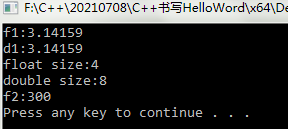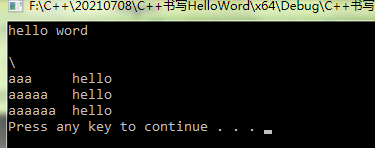- C++规定在创建一个变量或常量时,必须要指定相应的数据类型,否则无法给变量分配内存。
- 数据类型存在的意义:给变量分配一个合适的内存空间
1. 整型
- 作用: 整型变量表示整数类型的数据
- 类型:
| 数据类型 | 占用空间 | 取值范围 |
|---|---|---|
| short (短整型) | 2字节 | ? 2 15 -2^{15} ?215 ~ 2 15 2^{15} 215-1(-32768–32767) |
| int (整型) | 4字节 | ? 2 31 -2^{31} ?231 ~ 2 31 2^{31} 231-1 |
| long (长整型) | Win4字节,Linux:32位4字节,64位8字节 | ? 2 31 -2^{31} ?231 ~ 2 31 2^{31} 231-1 |
| longlong(长长整型) | 8字节 | ? 2 62 -2^{62} ?262 ~ 2 62 2^{62} 262-1 |
#include<iostream>
using namespace std;
int main()
{
//1、短整型
short num1 = 32768;//输出-32768
//2、整型
int num2 = 32768;
//3、长整型
long num3 = 10;
//4、长长整型
long long num4 = 10;
cout << "num1 = " << num1 << endl;
cout << "num2 = " << num2 << endl;
cout << "num3 = " << num3 << endl;
cout << "num4 = " << num4 << endl;
system("pause");
return 0;
}
2. sizeof关键字
- 作用: 利用sizeof关键字统计数据类型所占内存大小
- 语法: sizeof(数据类型/变量)
#include<iostream>
using namespace std;
int main()
{
//语法:sizeof(数据类型/变量)
short num1 = 10;
cout << "num1 size:" << sizeof(num1) << endl;
cout << "short size:" << sizeof(short) << endl;
int num2 = 2;
cout << "int size:" << sizeof(int) << endl;
long num3 = 4;
cout << "long size:" << sizeof(long) << endl;
long long num4 = 70;
cout << "long long size:" << sizeof(long long) << endl;
system("pause");
return 0;
}

3. 实型(浮点型)
- 作用: 表示小数
- 类型:
? ? ? ? 单精度float:4字节,7位有效数字
? ? ? ? 双精度double:8字节,15~16位有效数字
#include<iostream>
using namespace std;
int main()
{
//单精度:float
//双精度:double
//编译器默认小数位双精度,需要加f,
//否则还要把双精度转换为单精度
float f1 = 3.1415926f;
cout << "f1:" << f1 << endl;
double d1 = 3.1415926;
cout << "d1:" << d1 << endl;
//默认情况下,输出一个小数,会显示出6位有效数字
cout << "float size:" << sizeof(float) << endl;
cout << "double size:" << sizeof(double) << endl;
//科学计数法表示小数
float f2 = 3e2;//3*10^2
cout << "f2:" << f2 << endl;
float f3 = 3e-2;//3*0.1^2
system("pause");
return 0;
}

4. 字符型
- 作用: 字符型变量用于显示单个字符
- 语法: char ch = ‘a’; 单引号、单引号内只有单个字符
C++和C中字符型变量只占1个字节
字符型变量是将对应的ASCII编码(对应的编号)放入储存单元
eg:a — 97、b — 98
#include<iostream>
using namespace std;
int main()
{
//1、字符型变量创建方式
char ch1 = 'a';
cout << "ch1:" << ch1 << endl;
//2、字符型变量所占内存空间大小
cout << "char size:" << sizeof(char) << endl;
//3、字符型变量常见错误
//char ch2 = "b";//双引号报错
//char ch2 = 'abc';//多个字符报错
//4、字符型变量对应ASCII编码
//强制转为整型
cout << int(ch1) << endl;
//a:97 A:65
system("pause");
return 0;
}
5. 转义字符
- 作用: 用于表示一些不能显示出来的ASCII字符
- 常用: \ \n \t

#include<iostream>
using namespace std;
int main()
{
//转义字符
//换行符\n
cout << "hello word\n" << endl;
//反斜杠
cout<<"\\"<<endl;
//水平制表符\t 可以整齐的输出数据
cout << "aaa\thello" << endl;//aaa加空格一共8个字符
cout << "aaaaa\thello" << endl;
cout << "aaaaaa\thello" << endl;
system("pause");
return 0;
}

6. 字符串型
- 作用: 表示一串字符
- 风格:
????C风格字符串:char 名称[] = “字符串”;
????C++风格字符串:string 名称 = “字符串”;
#include<iostream>
using namespace std;
#include<string>//用C++风格写字符串,要包含这个头文件
int main()
{
//C风格
//注意:中括号、双引号
char str1[] = "hello word";
cout << "str1:"<<str1 << endl;
//C++风格
//#include<string>//用C++风格写字符串,要包含这个头文件
string str2 = "hi excel";
cout << "str2:" << str2 << endl;
system("pause");
return 0;
}

7. 布尔类型
- 作用: 代表真或假的值(占1个字节大小)
- true:1
- false:0
#include<iostream>
using namespace std;
int main()
{
//1、创建布尔类型数据
bool flag = true;//代表1
cout << flag << endl;
flag = false;//代表0
cout << flag << endl;
//2、查看布尔类型所占内存空间
cout << "bool size:" << sizeof(bool) << endl;
system("pause");
return 0;
}
